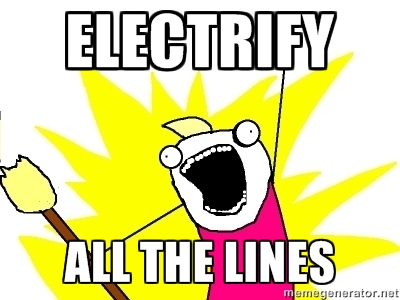How anyone can be a fan of building a small number of bespoke diesel locomotives - and providing all the supporting facilities they will require - to drag around very expensive electric trains is beyond me....
But people will keep going on about it, just as they will keep going on about how all express trains should have 10 coaches, a silver-service restaurant car, buffet counter with a selection of beers, wines and spirits, and a big blue engine on the front...
I'd be very surprised if anyone posting here wanders about wearing a badge that says "I'm a fan of bi-modes", it's just that some of us recognise that we are not going to electrify to everywhere all at once and that in the meantime there has to be a way to maintain through express services to the places that are not going to see wires for some years.
There appear to be two different ways of achieving that, bi-modes or a big blue engine, but not once, when I have asked you, or other fans of big blue engines, to explain what you do with the big blue engines when electrification is extended, have you come up with an answer.
The principle I have always worked to is simply that if a line has enough traffic to justify an express through service, it has enough traffic to justify the wires. If it doesn't, then it doesn't!
You then end up with two options. Either a diesel shuttle past the wires, or attach a diesel loco the front of the EMU. The fact that performance will be lower is negligible as by virtue of the fact it's not wired, there isn't enough of a business case for better services. If usage picks up and the wires get extended, then simple - design these locos as mixed traffic locos and they can either be found a home hauling freight (as I suspect a lot of freight-only lines will not be able to make a business case for wire for quite some time), or sell them overseas. Plus, you'll still want to keep Thunderbird locos around. Having a lot more around would probably be a boon when "incidents" occur.
Makes much more sense than dragging diesel engines around under the wires, day in, day out, that will be mostly pointless except at the extremes of their routes. Bi-mode is like having motorail coaches stuck on the end for passengers to bring their cars just in case the train breaks down.

